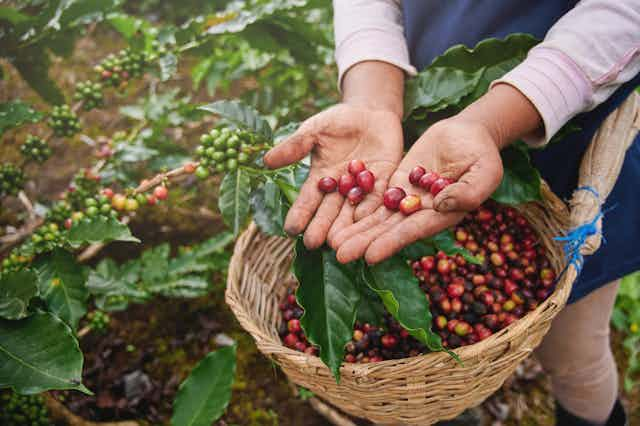A new genetic map of the arabica coffee plant, coffea arabica, could help breeders develop to more climate-proof brews.
Coffee is the second most consumed beverage on earth with over 2 billion cups being enjoyed every day. It’s also a valuable commodity and in 2023 the global market was worth over USD$93 billion (£74 billion).
With their superior smooth taste and many fine varieties, arabica coffee beans make up around 60%-70% of global coffee production. Coffee cultivation also directly supports the livelihoods of 25 million family farmers with another 100 million people involved in coffee processing and retailing.
But coffee crops are also threatened by climate change in many parts of the world and we need to use breeding to help the crops adapt to new conditions as well as growing them in areas that are less susceptible to factors such as drought.
This study could help produce coffee varieties with higher yields and more resilience to climate change. These new insights could not have come at a more important time for coffee crops.
Secrets of coffee genetics
A landmark study by an international group of scientists has uncovered the surprising genetic factors that underpin the diversity of the hundreds of arabica coffee varieties grown around the world. The new work, led by a team from the University of Udine, Italy, also reveals surprising similarities between the genetics of coffee and other important crops, including potatoes, brassicas and wheats.
These crops are known as tetraploids because they have four copies of each gene, instead of the two copies (one from each parent) found in humans and nearly all other animals. As shown below, the Arabica genome contains eleven groups of chromosomes each containing two copies from each of its respective parents, coffea canephora in blue and coffea eugenioides in green. In some cases parts of the blue and green chromosome segments have become mixed up.

Unlike edible crops such as wheat or potato, which have been highly bred over decades or centuries to create varieties that are drought-tolerant or pest-resistant – coffee has lagged behind in the application of modern breeding methods.
This includes the use of more precise DNA-based techniques such as genome editing that involves making changes to DNA. These methods, which are also used in medicine, enable us to identify and precisely manipulate the parts of a crop’s genome or genetic code to improve many aspects of performance.
With more detailed information about the genetic makeup of coffee, researchers can begin to use these methods to improve coffee varieties. One of the problems with arabica coffee is that our current varieties are not very diverse.
However, there are many wild species of coffee that are highly diverse and one goal will be to generate more resilient hybrids between the wild and cultivated species. This will allow breeders to produce a wider range of coffee varieties that could thrive in many different regions of the world.
Climate-proof coffee?
In 2022, a Swiss study showed that arabica coffee crops are facing unprecedented threats from climate change that could severely affect major growing regions such as Brazil and Ethiopia. Parts of these regions might become unsuitable for coffee cultivation due to increased drought incidence and threats from new pests or diseases.
Breeders are already applying advanced methods to develop other drought-tolerant crops. In the future, these could be applied to coffee. Indeed, earlier work in Portugal and Latin America has already shown that novel hybrid varieties from East Timor had useful disease resistance and a form of increased vigour called heterosis.
This new knowledge will expand the ability to produce novel coffee hybrids that suit locations such as India and New Caledonia where they could be a new crop for farmers.
While coffee crops face significant threats from climate change, it is heartening that we are now able to understand the wonderful genetic complexity of coffee plants in unprecedented detail. The new genetic knowledge could also lead to development of novel flavours that would further diversify the appeal of coffees in different regions of the world.
With the development of more precise breeding tools to produce more resilient varieties, coffee could be on the cusp of a new era for both farmers and consumers.

Don’t have time to read about climate change as much as you’d like?
Get a weekly roundup in your inbox instead. Every Wednesday, The Conversation’s environment editor writes Imagine, a short email that goes a little deeper into just one climate issue. Join the 30,000+ readers who’ve subscribed so far.

